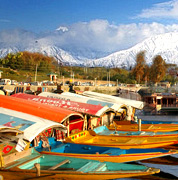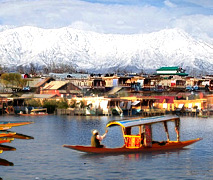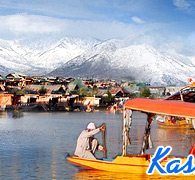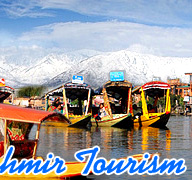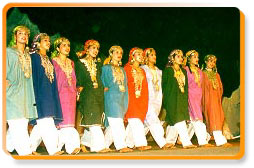 Distinct from the rest of the country, Jammu and
Kashmir sports a multifaceted, multicolored and unique cultural blend.
Not only the geographical conditions of the state are different but it
can also be set apart demographically with varied ethical and social
entities, diversity of religions flourishing in the area, different
language and cultural forms and heritage albeit with an over-reigning
harmony that blends in with the serenity and beauty of the region. One
gets dazed by the sheer diversity and richness of art and architecture,
fairs and festivals, rites and rituals, seers and sagas, languages and
mountains that thrive amongst the unparalleled cultural cohesion, which
is exemplary.
Distinct from the rest of the country, Jammu and
Kashmir sports a multifaceted, multicolored and unique cultural blend.
Not only the geographical conditions of the state are different but it
can also be set apart demographically with varied ethical and social
entities, diversity of religions flourishing in the area, different
language and cultural forms and heritage albeit with an over-reigning
harmony that blends in with the serenity and beauty of the region. One
gets dazed by the sheer diversity and richness of art and architecture,
fairs and festivals, rites and rituals, seers and sagas, languages and
mountains that thrive amongst the unparalleled cultural cohesion, which
is exemplary. Kashmir has been the highest learning centre of Sanskrit and Persian as Indo-Aryanic civilization has originated and flourished here. It also embraced the advent of Islam along with the virtues of Persian civilization such as tolerance, brotherhood and sacrifice. Nature's grand finale of beauty, Kashmir is the masterpiece of earth's creation and the folk performances of Kashmir are intimately mingled with the moods and movements of the seasons.
Jammu
Jammu, the land of the Dogras, has some beautiful dances and music that originated in its lap and were developed by the hardy and graceful women of the Duggar to divert themselves from the long spell of separations from their soldier husbands and brothers. Besides the purpose of adding cheer to their lives in their free moments, there are folk songs and dances that echo their feelings of separation and the ever-increasing yearning for reunion with the beloved, the hard life on the mountain slopes and various other themes that are connected with their day-to-day lives.
Kud
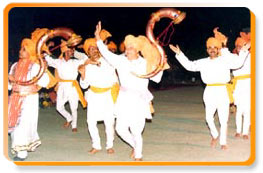 is basically a ritual dance performed in honor of Lok Devatas mostly
during nights. A spontaneous dance, people of all ages and sexes
participate in this folk dance form accompanied by musical instruments
used during this dance are Narshingha, chhaina, flute and drums. Heren
is a traditional theatre form performed during Lohri festival and is
mostly performed in hilly regions of Jammu. The ladies perform Fumenie
and Jagarana on the eve of groom's departure to in-laws house
accompanied by the songs are sung by a group of females. This
traditional dance form depicts the feelings and emotions of women folk.
Bakh is known by many different names such as Gwatri, Kark and Masade
and is actually a chorus narrative sung by a group of 10 singers without
the accompaniment of any musical instruments. Gawatri is a tradition in
which the singers narrate some text, which is enacted by the Gwatari
dancers. Karak is a ballad with a story sung by the Jogi community who
narrate a popular folk tale in their dance performance done by three
members to the accompaniment of typical folk instrument called Rabab.
The chorus singing tradition performed by specific tribal communities
called Gujjars and Bakerwals is known as Benthe, which 5 to 7 members
participate in the dance performance.
is basically a ritual dance performed in honor of Lok Devatas mostly
during nights. A spontaneous dance, people of all ages and sexes
participate in this folk dance form accompanied by musical instruments
used during this dance are Narshingha, chhaina, flute and drums. Heren
is a traditional theatre form performed during Lohri festival and is
mostly performed in hilly regions of Jammu. The ladies perform Fumenie
and Jagarana on the eve of groom's departure to in-laws house
accompanied by the songs are sung by a group of females. This
traditional dance form depicts the feelings and emotions of women folk.
Bakh is known by many different names such as Gwatri, Kark and Masade
and is actually a chorus narrative sung by a group of 10 singers without
the accompaniment of any musical instruments. Gawatri is a tradition in
which the singers narrate some text, which is enacted by the Gwatari
dancers. Karak is a ballad with a story sung by the Jogi community who
narrate a popular folk tale in their dance performance done by three
members to the accompaniment of typical folk instrument called Rabab.
The chorus singing tradition performed by specific tribal communities
called Gujjars and Bakerwals is known as Benthe, which 5 to 7 members
participate in the dance performance. Kashmir
region has its own musical performances that have won the hearts of many of its visitors. Bhand Pather is a traditional folk theatre style exhibiting combination of play and dance in a satirical style where social traditions, and evils are depicted and performed in various social and cultural functions. Bhand Jashan is performed by a group of 10 to 15 artists in their traditional style accompanied by light music for the entertainment of people. The most popular form of Kashmiri folk music is called Chakri that bears resemblance to Chakra of mountainous regions of Uttar Pradesh. It was accompanied by Garaha, Sarangi, Rabab once as the musical instruments but today harmonium plays an important role in its presentation. Sufiana Music migrated to Kashmir from Iran in the 15th century and flourished here as the classical music form of Kashmir. It absorbed a number of Indian Ragas and Hafiz Nagma was once a part of Sofiana Music. In Hafiz Nagma a dancer is a female while her accompanists on various instruments are males. An Hafiza (dancer) moves her feet on musical notes. The instruments that go with this form are Santoor, Sitar, Kashmiri Saz, Wasool or Tabala. Today, only a few families in Kashmir are practicing this musical for.




